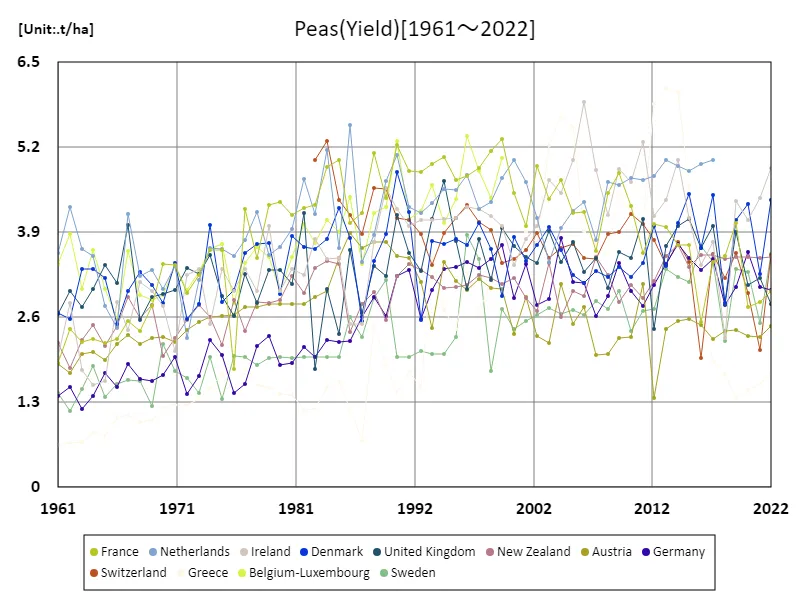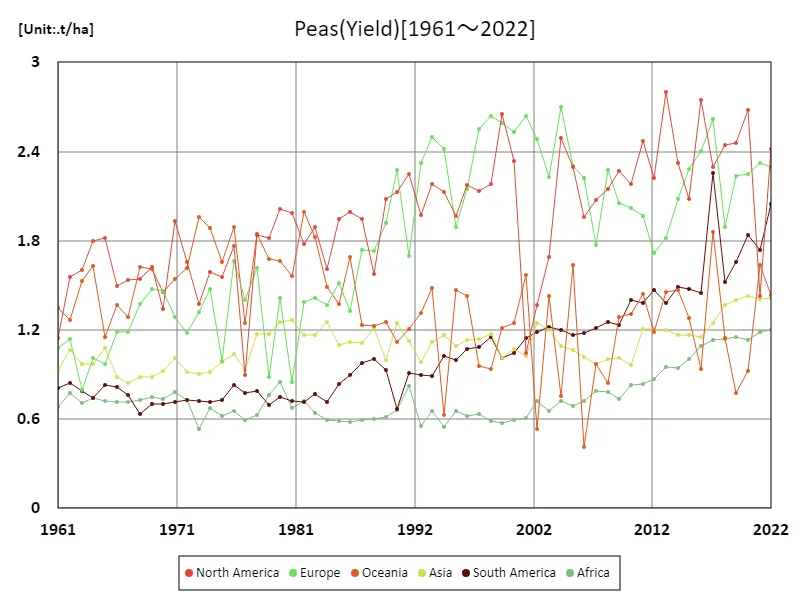Abstract
Field peas (Pisum sativum) are a globally cultivated crop valued for their protein-rich seeds and role in sustainable agriculture as a nitrogen-fixing legume. Historically, pea yields have varied widely due to differences in climate, soil fertility, and farming practices. Yields have generally improved over the decades due to advancements in agricultural technology, pest control, and improved cultivars. Ireland’s yield of 4.89 t/ha in 2022, the highest globally, highlights its favorable conditions, including mild climate and efficient farming practices. In contrast, yields in arid and tropical regions often lag due to water scarcity and poor soil conditions. Global efforts focus on enhancing productivity through sustainable practices and climate-resilient varieties.
Pea production (worldwide)
Field pea yields have shown significant variation globally from 1961 to 2022, influenced by advancements in agricultural practices, climate conditions, and regional differences. The highest recorded yield was 6.11 t/ha in Greece in 2013, a result of optimal weather, fertile soils, and intensive farming techniques. However, Greece’s current yield is just 28.4% of its peak, reflecting challenges like changing climatic conditions, economic shifts, and possibly reduced investment in high-yield cultivation. While some regions like Ireland are achieving record yields with advanced methods, overall trends highlight the need for innovation in sustainable practices to address environmental stresses and improve global productivity.


The maximum is 6.11t/ha[2013] of Greece, and the current value is about 28.4%
Pea production by country (latest year)
Pea production volumes in global agriculture exhibit significant disparities, influenced by regional conditions and agricultural practices. In 2022, the average yield was 1.86 t/ha, with Burundi achieving the highest at 5.5 t/ha, reflecting localized efficiency and favorable conditions. However, global production totaled only 177 t/ha, indicating the challenges many regions face, such as resource limitations, climatic variability, and less intensive farming. Over time, trends reveal steady improvements in yields driven by technological advances and improved crop varieties, yet the global average remains constrained by disparities in access to resources and adoption of modern techniques.


The maximum is 5.5t/ha of Burundi, the average is 1.86t/ha, and the total is 177t/ha
Pea production (continent)
Pea crop yields have steadily improved globally, driven by advancements in farming techniques and crop genetics. In 2022, the European Union recorded the highest yield at 4.26 t/ha, showcasing its favorable climate, fertile soils, and efficient agricultural practices. This highlights the EU’s focus on optimizing legume cultivation for food security and sustainable farming. While yields globally have shown gradual increases, significant regional disparities remain, influenced by climate, soil quality, and access to modern farming inputs. Trends point to growing emphasis on legumes for their ecological benefits, with continued research essential for bridging yield gaps across regions.


The maximum is 2.8t/ha[2013] of North America, and the current value is about 86.3%
Pea production (latest year, continental)
Pea crop yields in global agriculture reflect diverse regional performance and growing conditions. In 2022, North America recorded the highest average yield at 2.42 t/ha, driven by advanced farming technologies and efficient practices, exceeding the global average of 1.81 t/ha. Total global production reached 14.5 t/ha, highlighting the crop’s role in sustainable agriculture and protein supply. While yields have gradually increased due to improved varieties and techniques, challenges such as climate variability and resource access create disparities. Trends emphasize the importance of innovation and sustainability to enhance productivity and close regional gaps in yield performance.


The maximum is 2.42t/ha of North America, the average is 1.8t/ha, and the total is 10.8t/ha



Comments